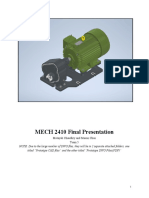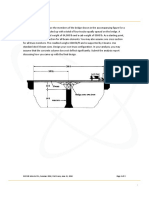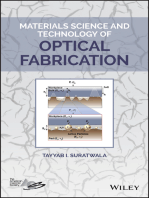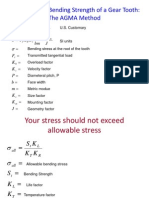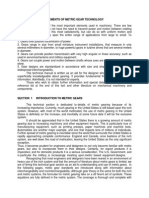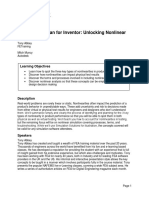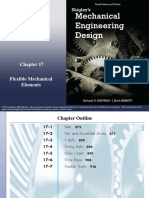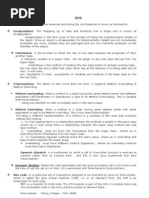HES3350 Machine Design, Semester 1, 2012, Assignment 1 - Compound Reverted Gear Train Design
HES3350 Machine Design, Semester 1, 2012, Assignment 1 - Compound Reverted Gear Train Design
Uploaded by
StephenPYBongCopyright:
Available Formats
HES3350 Machine Design, Semester 1, 2012, Assignment 1 - Compound Reverted Gear Train Design
HES3350 Machine Design, Semester 1, 2012, Assignment 1 - Compound Reverted Gear Train Design
Uploaded by
StephenPYBongCopyright
Available Formats
Share this document
Did you find this document useful?
Is this content inappropriate?
Copyright:
Available Formats
HES3350 Machine Design, Semester 1, 2012, Assignment 1 - Compound Reverted Gear Train Design
HES3350 Machine Design, Semester 1, 2012, Assignment 1 - Compound Reverted Gear Train Design
Uploaded by
StephenPYBongCopyright:
Available Formats
SWINBURNE UNIVERSITY OF TECHNOLOGY (SARAWAK CAMPUS) FACULTY OF ENGINEERING AND INDUSTRIAL SCIENCE
HES3350 Machine Design
Semester 1, 2012
Assignment 1: Compound Reverted Gear Train Design
By
Group No. 9
Stephen Bong Pi Yiing Kueh Min Hui Mohd Azmudin Bin Isa @ Danial Jimmy Huong How Lee
(4209168) (4209974) (4209028) (4209761)
Lecturer: Dr. Soon Kok Heng
Due Date: 30th March 2012 (Thursday), 4 pm
Assignment 1: Compound Reverted Gear Train Design TABLE OF CONTENTS
Group No. 9
PAGE ABSTRACT 1. 2. 3. OBJECTIVE INTRODUCTION MAIN CONTENT 3.1 3.2 3.3 3.4 4. Parameters and Schematic Diagram for Compound Reverted Gear Train Calculation of Number of Teeth for Gear 1, 2, 3, and 4 Calculation of Speed of the Intermediate & Output Shafts Calculation of the Torques Generated for the Input, Intermediate and Output Shafts 3 4 4 5 5 5-8 9 10 11 11 12-14 15-16 16 17 18
DISCUSSION 4.1 4.2 4.3 4.4 The Indispensability of Two Stage Compound Gear Train Gear Interference Compound Reverted Gear Train and the Benefits or Application of It Gear Reduction Ratio
5. 6.
CONCLUSION REFERENCES
HES3350 Machine Design, Semester 1, 2012
Page 2 of 18
Assignment 1: Compound Reverted Gear Train Design ABSTRACT
Group No. 9
The primary intention of this assignment is to determine the number of teeth for gear 1, 2, 3, and 4 utilized in a two-stage reduction gear train which serve as a speed reducer in a machine which is powered by an electric motor. The calculations in this report have reviewed that torques generated as a result of rotational motion of shafts and gears are inversely proportional to the angular velocities. Therefore, as the rotary motion is transmitted through the double reduction gear train, the reduction in velocities has results in an upsurge of torque generated. The indispensability of the utilization of double reduction gear train, gear interference, the advantages and applications of double reduction gear train, and the gear reduction ratio are discussed in this report as well. Apart from that, double reduction gear train has been extensively employed in wide range of engineering application which ranges from a can opener to an aircraft carries.
HES3350 Machine Design, Semester 1, 2012
Page 3 of 18
Assignment 1: Compound Reverted Gear Train Design 1. OBJECTIVE
Group No. 9
The primary intention of this assignment is to determine the number of teeth for gear 1, 2, 3, and 4 of a compound reverted gear train which plays as a role of speed reducer in a machine which is powered by an electric motor as shown in Fig. 1 below. Apart from that, the computations of speeds and torques generated for input, intermediate and output shafts as a result of the rotary motion of the gears are also the purposes of this assignment.
Fig. 1: A machine which is powered by an electric motor
2. INTRODUCTION
With the statistics and parameters provided such as the input and output speeds, the pressure angle, the module of the double-reduction gear train, and the power to be delivered in order to drive the motor; we are required to calculate the number of teeth for gear 1, 2, 3, and 4. The number of teeth for all the four gears are computed based on the prerequisites stated which are the axes of the driver and driven shafts are co-axial (inline of the output and input shafts) (see Fig. 2 below), and the minimum package size of the double-reduction gear train. In addition, the determination of the speeds and torques generated for input, intermediate and output shafts as a result of the rotational motion produced by the gears are incorporated in this report as well.
Fig. 2: Compound Reverted Gear Train (J. K. Brar & R. K. Bansal, 2004) Since this assignment by all means, cannot be tantamount to a real life design project as most of the calculations in the design of the compound reverted gear train are based on theoretical equations and appropriate assumptions such as the surfaces in contact are frictionless and therefore there has no power losses through the transmission. By neglecting the power losses due to friction, we only centralize our design based on the number of teeth of all the four gears, and the speed and torques generated for the input, intermediate and output shafts.
HES3350 Machine Design, Semester 1, 2012
Page 4 of 18
Assignment 1: Compound Reverted Gear Train Design 3. MAIN CONTENT
3.1 Parameters and Schematic Diagram for Compound Reverted Gear Train The schematic diagram for the compound reverted gear train is shown in Fig. 3 below:
Group No. 9
Fig. 3: Schematic of compound reverted gear train The parameters given are tabulated in Table 1 below: Power to Be Delivered (kW) Input Speed (rpm) Output Speed (rpm) Pressure Angle (Deg.) Module (mm) Table 1: Parameters given 3.2 Calculations of Number of Teeth for Gear 1, 2, 3, 4 The speed ratio of the double-reduction gear train utilized in this machine is given by: 27.5 1200 50 25 6
a a b d d d d N N = = 2 4 = 2 4 = 2 4 c b c d1 d 3 d1d 3 N1 N 3
where a = Input Speed b = Speed of Intermediate Shaft c = Output Speed d1 = Diameter of Gear 1 d2 = Diameter of Gear 2 d3 = Diameter of Gear 3 d4 = Diameter of Gear 4 N1 = Number of Teeth for Gear 1 N2 = Number of Teeth for Gear 2 N3 = Number of Teeth for Gear 3 N4 = Number of Teeth for Gear 4 Based on the information given, the speed ratio of the double-reduction gear train can be computed as follows:
a N 2 N 4 1200 rpm = = = 24 c N1 N 3 50 rpm
HES3350 Machine Design, Semester 1, 2012 Page 5 of 18
Assignment 1: Compound Reverted Gear Train Design
Therefore,
Group No. 9
N2 N4 = 24 N1 N 3
Given that the module, m, of the gear train is 6, thus,
Eq. [1]
m=
d d N d d = 1 = 2 =6 2 = 2 =6 N N1 N 2 N 1 d1
Eq. [2]
By substituting Eq. [2] into Eq. [1] gives:
N N2 N4 = 24 6 4 N N1 N 3 3
N = 24 4 = 4 N 4 = 4 N 3 N3
Eq. [3]
In order to make the axes of the driver and driven shafts become collinear (Inline input and output shafts), the center distance between gear 1 and gear 2 should be equal to the center distance between gear 3 and gear 4.
c1 2 = c34
d1 + d 2 d 3 + d 4 = d1 + d 2 = d 3 + d 4 2 2
Eq. [4]
Since m = d/N or d = mN, hence Eq. [4] above becomes:
mN 1 + mN 2 = mN 3 + mN 4
Since the module of the entire gear train is similar, Eq. [5] can be reduced to:
Eq. [5]
N1 + N 2 = N 3 + N 4
The smallest number of teeth, Np, on a spur pinion or gear without interference is given by
Eq. [6]
Np =
2 m + m 2 + (1 + 2m ) sin 2
)
= 25) into Eq. [7] yields:
(1 + 2m )sin
2
Eq. [7]
By substituting the data given (m = 6 mm and
2 6 + 6 2 + [1 + 2(6 )]sin 2 (25) Np = = 10.71 11 [1 + 2(6)]sin 2 (25)
Let Np = N1 = 11, from Eq. [2],
N2 = 6 N 2 = 6 N1 = 6(11) = 66 N1
Since N4 = 4N3, and substituting N1 = 11 and N2 = 66 into Eq. [6] gives:
11 + 66 = N 3 + 4 N 3 77 = 5 N 3 N 3 = 15.4
Since the number of teeth of gear must be an integer, therefore, N3 = 15.4 cannot be accepted. Thus, in order to obtain an integer number of teeth, trial and error method had been selected.
HES3350 Machine Design, Semester 1, 2012
Page 6 of 18
Assignment 1: Compound Reverted Gear Train Design
Group No. 9
Since the minimum number of teeth for one of the gear in the compound reverted gear train is Np = 11, hence the integer number of teeth utilized in the trial and error method should be greater than 11 in order to avoid interference of gears. By trial and error, 1st Trial (N1 = 12) From Eq. [2] N2 = 6N1 = 6(12) = 72 Since N1 + N2 = N3 + N4, and N4 = 4N3, therefore,
12 + 72 = N3 + 4N3 84 = 5N3 N3 = 16.8 (Not accepted)
2nd Trial (N1 = 13) From Eq. [2] N2 = 6N1 = 6(13) = 78 Since N1 + N2 = N3 + N4, and N4 = 4N3, therefore,
13 + 78 = N3 + 4N3 91 = 5N3 N3 = 18.2 (Not accepted)
3rd Trial (N1 = 14) From Eq. [2] N2 = 6N1 = 6(14) = 84 Since N1 + N2 = N3 + N4, and N4 = 4N3, therefore,
14 + 84 = N3 + 4N3 98 = 5N3 N3 = 19.6 (Not accepted)
4th Trial (N1 = 15) From Eq. [2] N2 = 6N1 = 6(15) = 90 Since N1 + N2 = N3 + N4, and N4 = 4N3, therefore,
15 + 90 = N3 + 4N3 105 = 5N3 N3 = 21 (Accepted)
Based on the calculations from the 1st Trial to the 4th Trial, N1 = 15 is the 1st integer number of teeth for gear 1 which can results in an integer number of teeth for gear 3 which is N3 = 21. Thus, N1 = 15 is acceptable. With N1 = 15, we know that N3 = 21, N4 can be computed by using Eq. [3]:
N4 = 4N3 = 4(21) = 84
Thus, on the basis of the calculations above and the prerequisites stated, the number of teeth for gear 1, 2, 3, 4 are N1 = 15, N2 = 90, N3 = 21, and N4 = 84.
HES3350 Machine Design, Semester 1, 2012
Page 7 of 18
Assignment 1: Compound Reverted Gear Train Design
Group No. 9
Based on the number of teeth computed for gear 1, 2, 3 & 4, a double-reduction gear train is sketched by using SolidWorks and shown in Fig. 4 below.
Fig. 4: Drawing of gears in the double-reduction gear train with N1 = 15, N2 = 90, N3 = 21, and N4 = 84 by using SolidWorks
HES3350 Machine Design, Semester 1, 2012
Page 8 of 18
Assignment 1: Compound Reverted Gear Train Design
3.3 Calculations of the Speeds of the Intermediate and Output Shafts
Group No. 9
Since the module is constant throughout the entire compound reverted gear train, thus,
m=
d d1 d d = 2 = 3 = 4 N1 N 2 N 3 N 4
With the number of teeth for all the four gears known, the diameter of each gear can be computed as follows:
d1 = mN1 = (6)(15) = 90 mm d 2 = mN 2 = (6)(90) = 540 mm
d 3 = mN 3 = (6 )(21) = 126 mm
d 4 = mN 4 = (6)(84) = 504 mm
Based on the diameter of each gear computed above, the center distance for gear 1 and gear 2, and gear 3 and gear 4 are calculated as follows:
c1 2 =
d 1 + d 2 90 mm + 540 mm = = 315 mm 2 2 d 3 + d 4 126 mm + 504 mm = = 315 mm 2 2
c 3 4 =
On account of c1 2 = c3 4, therefore, the condition of inline input and output shafts is accomplished. The gear ratio of gear 1 and gear 2 is given by:
g r ,1 2 =
d 2 a = d1 b
With d1 = 90 mm, d2 = 540 mm, and a = 1200 rpm, the speed of the intermediate shaft, b, can be obtained as follows:
b = a
d1 d2
90 = 1200 rpm = 200 rpm 540
Therefore, the speeds for the input, intermediate, and output shafts are a = 1200 rpm, b = 200 rpm, and c = 50 rpm respectively.
HES3350 Machine Design, Semester 1, 2012
Page 9 of 18
Assignment 1: Compound Reverted Gear Train Design
3.4
Group No. 9
Calculations of the Torques Generated for the Input, Intermediate and Output Shafts
Since there has no power loss throughout the entire transmission, thus the only parameters which influence the torque generated as a result of gears rotate is the speed of each shafts. The torque & generated can be computed by utilizing the relation of power and torque, W = T . Based on the information given and calculations above, we know that
= 27.5 kW a = 1200 rpm b = 200 rpm c = 50 rpm
The torques for the input, intermediate and output shafts are computed as follows:
Ta =
& W
a
& W
27.5 10 3 W = 218.84 N m rev 1 min 2 rad 1200 min 60 s 1 rev 27.5 10 3 W = 1313.03 N m rev 1 min 2 rad 200 min 60 s 1 rev 27.5 10 3 W = 5252.11 N m rev 1 min 2 rad 50 min 60 s 1 rev
Tb =
b
& W
Tc =
HES3350 Machine Design, Semester 1, 2012
Page 10 of 18
Assignment 1: Compound Reverted Gear Train Design
Group No. 9
4.
4.1
DISCUSSION
The Indispensability of Two Stage Compound Gear Train
Gear trains are extensively applicable in wide range of engineering applications such as all varieties of mechanisms and machines which ranged from a can opener to aircraft carries. Gear trains will usually be utilized whenever a variation in velocity or torque of a rotating device is required (Norton, R. L., 2004, p. 462). According to Norton, R. L. (2004), a gear train can be interpreted as any collection of two or more meshing gears for the purpose of power transmission from one shaft to another (Gupta, J. K. & Khurmi, R. S., 2000, p. 412). A gear train may encompass of spur gears, bevel gears, or spiral gears, depending on how much speeds and power output to be generated. Distinct arrangement of gears and wheels will results in different types of gear trains such as simple gear train, compound gear train, reverted gear train, and epicyclic gear train. Norton, R. L. (2004) states that a compound gear train is one in which at least one shaft carries more than one gear. The arrangement of gears and wheels in a compound gear train is either a parallel or series-parallel arrangement, rather than the pure series connections of the simple gear train. Fig. 5 below shows a two stage compound gear train which consists of four gears and two of which, gear 3 and gear 4, are regularized on the same shaft and therefore have the same angular velocity.
Fig. 5: A two stage compound gear train (Norton, R. L., 2004, p. 484) Although the idle gears utilized in simple gear train do not influence the speed ratio of the entire system, nevertheless these gears are beneficial in bridging over the space between the driver (gear 2) and the driven (gear 5). Whenever the offset between the driver and the driven has to be bridged over by intermediate gears and a great speed ratio is demanded simultaneously, and then the dominant position of intermediate gears (gear 3 & 4 see Fig. 4 above) is intensified by furnishing compound gears on the intermediate shaft. In contrast with simple gear train, a much larger speed reduction will occurred as a result of a compound gear train being utilized. If a simple gear train is utilized in order to provide a large reduction in angular velocity, the size of the large gear has to be very huge. Generally for a speed reduction ratio which exceeds the ratio of 7 to 1, the utilization of a simple gear train is not convenient, and a compound gear train is employed. Based on the calculations in Section 4.2 above, the speed ratio computed from the given parameters is 24 to 1 which exceeds 7 to 1, therefore, the application of a twostage compound gear train is necessary (Gupta, J. K. & Khurmi, R. S., 2000, p. 414-416).
HES3350 Machine Design, Semester 1, 2012
Page 11 of 18
Assignment 1: Compound Reverted Gear Train Design
4.2 Gear Interference
Group No. 9
In order to interpret the theories of interference and undercutting of gears in details, it is significance to have a proper comprehending on each of the nomenclature of involute gear teeth. The nomenclature of involute gear teeth is shown in Fig. 6 below.
Fig. 6: Nomenclature of involute gear teeth (Juvinall, R. C. & Marshek, K. M., 2012, p. 596)
HES3350 Machine Design, Semester 1, 2012
Page 12 of 18
Assignment 1: Compound Reverted Gear Train Design
Group No. 9
According to Norton, R. L., (2004), the contact ratio of a pair of gears, mp, can be defined as the average number of teeth in contact at any instant and it can be expressed mathematically as:
mp =
Z pb
where Z is the length of action; Z =
(r
+ a p ) (rp cos ) +
2 2
(r
+ a g ) (rg cos ) C sin
2 2
pb is the base pitch, pb = p c cos , p c =
d
N
A contact ratio of 1, for example, implies that one tooth is leaving contact just as the next is beginning contact. This is objectionable as some unwanted circumstances such as oscillations in velocity, vibration, and noise will occurred if there are miscalculations in the analysis and design of tooth spacing. Apart from that, there is also a high possibility for bending to occurred due to the applied loads at the tip of the tooth. Therefore, the contact ratio which falls between the ranges of 1.2 to 1.6 has usually selected and employed in the design of spur gears as the utilization of higher contact ratio will increase the possibility of load sharing among the teeth. Gears with contact ratios which exceed 2 are often referred to as highcontact ratio gears and there are always in perpetuity less than two pairs of teeth in contact. The selection and utilization of high contact ratio gears is often being the first priority in most of the applications where long term operations are required. In the design of high-contact ratio gears, detailed analysis should always take into account and considerations as the tooth dedendum region might experience a higher bending stresses due to higher dynamic loading subjected. Apart from that, the distress of the tooth surfaces might be occurred due to higher sliding in tooth contact (Brown, T. H. & Rothbart, H., 2006; Norton, R. L., 2004, p. 474). Generally, the involute curve is only defined beyond the base circle, but in some state of affairs, the dedendum will be large enough to broaden below the base circle or the addendum circles extends beyond the tangent points A and B (see Fig. 7 below) which are called interference points (Juvinall, R. C. & Marshek, K. M., 2006, p. 601). This will lead to the portion of tooth below the base circle will not be an involute and will intervene with the tip of the tooth on the mating gear (Norton, R. L., 2004, p. 472). This non-conjugate action is referred to as gear interference. If a standard gear sharper is utilized to cut the gear, interference will occurred between the cutting tool and the portion of tooth below the base circle as well. As a result, the interfering material will be cut away and results in an undercut tooth as shown in Fig. 8 below. When the interfered materials had been removed due to undercutting and the maximum shear and bending from the tooth loaded as a cantilever beam both happen in this portion, the tooth will be weaken and lead to early tooth failure. Interference and undercutting can be forestalled by refrain from utilizing gears with little number of teeth as the number of teeth is decreased for a regularized diameter gear, the size of the teeth must be large enough in order drive the other gear. As the driver gear rotates to some point, the dedendum will exceed the radial distance between the base circle and the pitch circle, and thus result in gear interference (Norton, R. L., 2004, p. 472).
HES3350 Machine Design, Semester 1, 2012
Page 13 of 18
Assignment 1: Compound Reverted Gear Train Design
Group No. 9
Fig. 7: Interference in the action of gear teeth (Interference is on flank of pinion during approach action and flank of gear during recess action) (Brown, T. H. & Rothbart, H., 2006)
Fig. 8: Interference and undercutting of teeth below the base circle (Norton, R. L., 2004)
HES3350 Machine Design, Semester 1, 2012
Page 14 of 18
Assignment 1: Compound Reverted Gear Train Design
4.3 Compound Reverted Gear Train and The Benefits or Applications of It
Group No. 9
The distinction between compound gear train and compound reverted gear train is that the locations of input and output shafts are different. For such compound gear train, in which the input and output shafts are not coincident, is called a non-reverted compound gear train. On the contrary, a compound gear train can be referred as a compound reverted gear train if the input and output shafts are in exact alignment (output shaft concentric with the input shaft) (see Fig. 9 below). The design and analysis of a compound reverted gear train is furthermore complicated as compared to compound gear train due appended constraint and restriction which is the center distances of each stage must be equal.
Fig. 9: A compound reverted gear train (Norton, R. L., 2004, p. 487) Molian, S. (1982) listed that one of the advantage of the utilization of compound reverted gear train is the amount of power to be transmitted can be increased by a train of given overall size. Compound reverted gear trains are extensively employed in manual automotive transmission to offer user-selectable ratios between the engine and the drive wheels for torque multiplication. These gearboxes generally encompass of four forward speeds and one reverse as shown in Fig. 10 below. Based on Fig. 10 below, the input shaft is located on the top left corner of the gearbox and the input gear is always in mesh with the leftmost counter-gear on the countershaft at the bottom. This countershaft has several counter-gears integral with it and each of which meshes with a distinct output gear which is freewheeling on the output shaft. The output shaft of the five-speed gearbox is concentric with the input shaft and they are linked by means of the counter-gears on the countershaft (Norton, R. L., 2004, p. 504). Apart from the utilization of compound reverted gear train in manual automobile transmission, it is also employed in wide range of engineering and industrial applications such as lathe back gears, industrial speed reducers, and mechanical watches and clocks in which the minute and hour hand shafts are concentric (Gupta, J. K. & Khurmi, R. S., 2000, p. 419).
HES3350 Machine Design, Semester 1, 2012
Page 15 of 18
Assignment 1: Compound Reverted Gear Train Design
Group No. 9
Fig. 10: 5-Speed gearbox 4.4 Gear Reduction Ratio
Gear reduction ratio is a proportion that used to describes the ratio of angular velocities between the input shaft and the output shaft. The angular velocity of the gear can be reduced by utilizing a pair of gear with a reduction ratio of 2 to 1 as the pinion would have to complete 2 revolutions in order to drive the gear to complete 1 revolution of rotational motion (Brett Buzz Dawson, 2002; Pauline, G., 2012). From the equation which relates power and torque, = T or T = /, it can easily be seen that the torque generated is inversely proportional to the angular velocity of the gears. Therefore, a doublereduction gear train has been selected in order to minimize the angular velocity so that a larger torque and power output can be generated.
HES3350 Machine Design, Semester 1, 2012
Page 16 of 18
Assignment 1: Compound Reverted Gear Train Design
Group No. 9
5.
CONCLUSION
Through this assignment, our knowledge on the design and analysis of gear mechanism had improved immensely. Based on the parameters provided, we had computed the number of teeth for gear 1, 2, 3, and 4 in the two-stage reduction gear train in conjunction with the pre-requisite stated. Apart from that, according to the calculations in Section 3.3 and 3.4, we had found that the reduction in angular velocities due to the transmission of rotary motion from gear 1 to gear 2, and gear 3 to gear 4 has leads to an upsurge in torques generated. According to the relation of power and torque, it can be clearly shows that the torque generated is inversely proportional to the angular velocity. Besides, since the velocity ratio computed in Section 4.2 is 24 to 1 which exceeds the general velocity ratio of simple gear train, therefore, the application of a two-stage compound gear train is indispensable. In this report, a two-stage reduction gear train which encompasses of gear 1, 2, 3, and 4 with their respective number of teeth had designed. Based on the theoretical analysis of gear tooth, it had been proven mathematically that the gear train has the capability to furnish ample amount of torques so that the electric motor can be driven perfectly. But there are some other factors and parameters which had been neglected due to the assumptions made and have the possibility to influence the overall performance and mechanical efficiency of the entire gear train exists in the authentic design of two-stage compound gear train. As a verdict, double reduction gear train has been extensively employed in wide range of engineering and industrial applications as a large amount of power can be transmitted by a train of given overall size. And this will leads to an upsurge of performance and mechanical efficiency of the machine.
HES3350 Machine Design, Semester 1, 2012
Page 17 of 18
Assignment 1: Compound Reverted Gear Train Design
Group No. 9
6.
REFERENCES
Brett Buzz Dawson, 2002, Understanding Gear Reduction, Team DaVinci Robotics, viewed on 28 March, 2012. < http://www.teamdavinci.com/understanding_gear_reduction.htm> Brown, T. H. & Rothbart, H., 2006, Mechanical Design Handbook, Measurement, Analysis, and Control of Dynamic Systems CONTRIBUTORS, McGraw-Hill Companies, Inc., New York. Hamrock, B. J., Schmid, S. R., and Jacobson, Bo. O., 2005, FUNDAMENTALS OF MACHINE ELEMENTS, 2nd ed., McGraw-Hill Companies, Inc., Anvenue of the Americas, New York. Juvinall, R. C. and Marshek, K. M., 2012, Machine Component Design, 5th ed., John Wiley & Sons Inc. Khurmi, R. S. and Gupta, J. K., 2000, Theory of Machines, S. Chand & Company Ltd, India. Molian, S., Mechanism design An introductory text, 1982, Cambridge University Press Norton, R. L., 2004, DESIGN OF MACHINERY An Introduction to the Synthesis and Analysis of Mechanism and Machines, 3rd ed., McGraw-Hill Education (Asia), Singapore. Pauline Gill, 2012, How to Calculate Reduction Ratio, eHow, viewed on 28 March, 2012. <http://www.ehow.com/how_6602288_calculate-reduction-ratio.html#ixzz1qX0fsT7u>
HES3350 Machine Design, Semester 1, 2012
Page 18 of 18
You might also like
- MECH 2410 Final Presentation: Titled "Prototype CAD Files" and The Other Titled "Prototype DWG Files (PDF) "No ratings yetMECH 2410 Final Presentation: Titled "Prototype CAD Files" and The Other Titled "Prototype DWG Files (PDF) "17 pages
- HES3350 Machine Design, Assignment 2: Gear Specification With Consideration of Bending Fatigue and Surface Durability (Semester 1, 2012)No ratings yetHES3350 Machine Design, Assignment 2: Gear Specification With Consideration of Bending Fatigue and Surface Durability (Semester 1, 2012)21 pages
- HES3350 Machine Design Semester 1 2012 Assignment 1 Compound Reverted Gear Train Design PDFNo ratings yetHES3350 Machine Design Semester 1 2012 Assignment 1 Compound Reverted Gear Train Design PDF18 pages
- Design Optimization of Fluid Machinery: Applying Computational Fluid Dynamics and Numerical OptimizationFrom EverandDesign Optimization of Fluid Machinery: Applying Computational Fluid Dynamics and Numerical OptimizationNo ratings yet
- Materials Science and Technology of Optical FabricationFrom EverandMaterials Science and Technology of Optical FabricationNo ratings yet
- IJIRAE::Design and DMU Kinematic Analysis of Slider Crank Mechanism Using CATIA and MATLABNo ratings yetIJIRAE::Design and DMU Kinematic Analysis of Slider Crank Mechanism Using CATIA and MATLAB6 pages
- Rack and Pinion Design For Wave Energy ConverterNo ratings yetRack and Pinion Design For Wave Energy Converter5 pages
- 8,000 RPM APU Size To 30,000 RPM Miniature, Aerospace ApplicationsNo ratings yet8,000 RPM APU Size To 30,000 RPM Miniature, Aerospace Applications9 pages
- Me 2352 Design of Transmission Systems: III Year MechanicalNo ratings yetMe 2352 Design of Transmission Systems: III Year Mechanical14 pages
- Mechatronics Key Elements Information System: Modeling and SimulationNo ratings yetMechatronics Key Elements Information System: Modeling and Simulation2 pages
- Autodesk Nastran For Inventor: Unlocking Nonlinear Analysis: Learning ObjectivesNo ratings yetAutodesk Nastran For Inventor: Unlocking Nonlinear Analysis: Learning Objectives17 pages
- Understanding Frequency Domain Viscoelasticity in AbaqusNo ratings yetUnderstanding Frequency Domain Viscoelasticity in Abaqus13 pages
- Design of Machinery: Chapter 1 Introduction Summary100% (2)Design of Machinery: Chapter 1 Introduction Summary9 pages
- Dynamic Model of Robot Manipulators: Claudio MelchiorriNo ratings yetDynamic Model of Robot Manipulators: Claudio Melchiorri65 pages
- Engineering Economy Solution Manual PooNo ratings yetEngineering Economy Solution Manual Poo301 pages
- Hydraulic efficiency η h= Power output Energy available ∈the jet PNo ratings yetHydraulic efficiency η h= Power output Energy available ∈the jet P3 pages
- Product Design and Development With Reverse EngineeringNo ratings yetProduct Design and Development With Reverse Engineering30 pages
- Vibration Analysis For Electronic Equipment Electronics Cooling Magazine - Focused On Thermal Management, TIMs, Fans, Heat Sinks, CFD Software, LEDs - LightingNo ratings yetVibration Analysis For Electronic Equipment Electronics Cooling Magazine - Focused On Thermal Management, TIMs, Fans, Heat Sinks, CFD Software, LEDs - Lighting4 pages
- Dynamics and Control of Robotic Manipulators with Contact and FrictionFrom EverandDynamics and Control of Robotic Manipulators with Contact and FrictionNo ratings yet
- Hoi Wan SCCS Certification Report FINAL PDFNo ratings yetHoi Wan SCCS Certification Report FINAL PDF12 pages
- HES5340 Fluid Mechanics 2, Lab 2 - COMPRESSIBLE FLOW (Converging-Diverging Duct Test) (Semester 2, 2012) by Stephen, P. Y. Bong63% (8)HES5340 Fluid Mechanics 2, Lab 2 - COMPRESSIBLE FLOW (Converging-Diverging Duct Test) (Semester 2, 2012) by Stephen, P. Y. Bong26 pages
- STPM Mathematics (T) Assignment B: Mathematical Modelling (2013)100% (5)STPM Mathematics (T) Assignment B: Mathematical Modelling (2013)11 pages
- STPM Mathematics (T) (2013) Assignment B: Mathematical Modeling by Stephen, P. Y. Bong80% (5)STPM Mathematics (T) (2013) Assignment B: Mathematical Modeling by Stephen, P. Y. Bong2 pages
- HES5340 Fluid Mechanics 2, Semester 2, 2012, Lab 1 - Aerofoil and Pressure Cylinder Test by Stephen, P. Y. Bong0% (1)HES5340 Fluid Mechanics 2, Semester 2, 2012, Lab 1 - Aerofoil and Pressure Cylinder Test by Stephen, P. Y. Bong23 pages
- HES2340 Fluid Mechanics 1, Semester 1, 2012, Assignment 2No ratings yetHES2340 Fluid Mechanics 1, Semester 1, 2012, Assignment 213 pages
- HES5320 Solid Mechanics, Semester 2, 2011, Practical Lab On Thick-Walled Cylinder by Stephen Bong100% (5)HES5320 Solid Mechanics, Semester 2, 2011, Practical Lab On Thick-Walled Cylinder by Stephen Bong17 pages
- HES5320 Solid Mechanics, Semester 2, 2011, Practical Lab On Thick-Walled Cylinder by Stephen Bong100% (5)HES5320 Solid Mechanics, Semester 2, 2011, Practical Lab On Thick-Walled Cylinder by Stephen Bong17 pages
- HES5310 Machine Dynamics 2, Semester 1, 2012, Assignment 2100% (1)HES5310 Machine Dynamics 2, Semester 1, 2012, Assignment 257 pages
- Quarter 2 - MELC 6: Mathematics Activity SheetNo ratings yetQuarter 2 - MELC 6: Mathematics Activity Sheet7 pages
- Sta1503 2013 s01 - Assignment02 Memo - TL 202 2013 1 eNo ratings yetSta1503 2013 s01 - Assignment02 Memo - TL 202 2013 1 e5 pages
- Analisis Kebijakan Kredit Terhadap Efektivitas Pengumpulan Piutang Di Bali Garden HotelNo ratings yetAnalisis Kebijakan Kredit Terhadap Efektivitas Pengumpulan Piutang Di Bali Garden Hotel14 pages
- PRACTICAL FILE (BCA-107)FRONT PAGE AND INDEX (1)No ratings yetPRACTICAL FILE (BCA-107)FRONT PAGE AND INDEX (1)2 pages
- Calculation Dilute Phase Pressure Drop Rhodes MethodNo ratings yetCalculation Dilute Phase Pressure Drop Rhodes Method3 pages
- (Chapman & Hall - Financial Mathematics Series) Damien Lamberton, Bernard Lapeyre, Nicolas Rabeau, Francois Mantion - Introduction To Stochastic Calculus Applied To Finance-Chapman & Hall (1996)No ratings yet(Chapman & Hall - Financial Mathematics Series) Damien Lamberton, Bernard Lapeyre, Nicolas Rabeau, Francois Mantion - Introduction To Stochastic Calculus Applied To Finance-Chapman & Hall (1996)99 pages
- AWWA C208-17 Dimensions For Fabricated Steel Water Pipe Fittings100% (2)AWWA C208-17 Dimensions For Fabricated Steel Water Pipe Fittings32 pages
- PKI Key Generation Based On Iris Features: Yazhuo Gong Kaifa Deng Pengfei ShiNo ratings yetPKI Key Generation Based On Iris Features: Yazhuo Gong Kaifa Deng Pengfei Shi4 pages
- Evaluation of The Ductile-To-Brittle Transition Temperature in Steel Low CarbonNo ratings yetEvaluation of The Ductile-To-Brittle Transition Temperature in Steel Low Carbon12 pages
- MECH 2410 Final Presentation: Titled "Prototype CAD Files" and The Other Titled "Prototype DWG Files (PDF) "MECH 2410 Final Presentation: Titled "Prototype CAD Files" and The Other Titled "Prototype DWG Files (PDF) "
- HES3350 Machine Design, Assignment 2: Gear Specification With Consideration of Bending Fatigue and Surface Durability (Semester 1, 2012)HES3350 Machine Design, Assignment 2: Gear Specification With Consideration of Bending Fatigue and Surface Durability (Semester 1, 2012)
- HES3350 Machine Design Semester 1 2012 Assignment 1 Compound Reverted Gear Train Design PDFHES3350 Machine Design Semester 1 2012 Assignment 1 Compound Reverted Gear Train Design PDF
- Design Optimization of Fluid Machinery: Applying Computational Fluid Dynamics and Numerical OptimizationFrom EverandDesign Optimization of Fluid Machinery: Applying Computational Fluid Dynamics and Numerical Optimization
- Materials Science and Technology of Optical FabricationFrom EverandMaterials Science and Technology of Optical Fabrication
- IJIRAE::Design and DMU Kinematic Analysis of Slider Crank Mechanism Using CATIA and MATLABIJIRAE::Design and DMU Kinematic Analysis of Slider Crank Mechanism Using CATIA and MATLAB
- 8,000 RPM APU Size To 30,000 RPM Miniature, Aerospace Applications8,000 RPM APU Size To 30,000 RPM Miniature, Aerospace Applications
- Me 2352 Design of Transmission Systems: III Year MechanicalMe 2352 Design of Transmission Systems: III Year Mechanical
- Mechatronics Key Elements Information System: Modeling and SimulationMechatronics Key Elements Information System: Modeling and Simulation
- Autodesk Nastran For Inventor: Unlocking Nonlinear Analysis: Learning ObjectivesAutodesk Nastran For Inventor: Unlocking Nonlinear Analysis: Learning Objectives
- Understanding Frequency Domain Viscoelasticity in AbaqusUnderstanding Frequency Domain Viscoelasticity in Abaqus
- Design of Machinery: Chapter 1 Introduction SummaryDesign of Machinery: Chapter 1 Introduction Summary
- Dynamic Model of Robot Manipulators: Claudio MelchiorriDynamic Model of Robot Manipulators: Claudio Melchiorri
- Hydraulic efficiency η h= Power output Energy available ∈the jet PHydraulic efficiency η h= Power output Energy available ∈the jet P
- Product Design and Development With Reverse EngineeringProduct Design and Development With Reverse Engineering
- Vibration Analysis For Electronic Equipment Electronics Cooling Magazine - Focused On Thermal Management, TIMs, Fans, Heat Sinks, CFD Software, LEDs - LightingVibration Analysis For Electronic Equipment Electronics Cooling Magazine - Focused On Thermal Management, TIMs, Fans, Heat Sinks, CFD Software, LEDs - Lighting
- Dynamics and Control of Robotic Manipulators with Contact and FrictionFrom EverandDynamics and Control of Robotic Manipulators with Contact and Friction
- HES5340 Fluid Mechanics 2, Lab 2 - COMPRESSIBLE FLOW (Converging-Diverging Duct Test) (Semester 2, 2012) by Stephen, P. Y. BongHES5340 Fluid Mechanics 2, Lab 2 - COMPRESSIBLE FLOW (Converging-Diverging Duct Test) (Semester 2, 2012) by Stephen, P. Y. Bong
- STPM Mathematics (T) Assignment B: Mathematical Modelling (2013)STPM Mathematics (T) Assignment B: Mathematical Modelling (2013)
- STPM Mathematics (T) (2013) Assignment B: Mathematical Modeling by Stephen, P. Y. BongSTPM Mathematics (T) (2013) Assignment B: Mathematical Modeling by Stephen, P. Y. Bong
- HES5340 Fluid Mechanics 2, Semester 2, 2012, Lab 1 - Aerofoil and Pressure Cylinder Test by Stephen, P. Y. BongHES5340 Fluid Mechanics 2, Semester 2, 2012, Lab 1 - Aerofoil and Pressure Cylinder Test by Stephen, P. Y. Bong
- HES2340 Fluid Mechanics 1, Semester 1, 2012, Assignment 2HES2340 Fluid Mechanics 1, Semester 1, 2012, Assignment 2
- HES5320 Solid Mechanics, Semester 2, 2011, Practical Lab On Thick-Walled Cylinder by Stephen BongHES5320 Solid Mechanics, Semester 2, 2011, Practical Lab On Thick-Walled Cylinder by Stephen Bong
- HES5320 Solid Mechanics, Semester 2, 2011, Practical Lab On Thick-Walled Cylinder by Stephen BongHES5320 Solid Mechanics, Semester 2, 2011, Practical Lab On Thick-Walled Cylinder by Stephen Bong
- HES5310 Machine Dynamics 2, Semester 1, 2012, Assignment 2HES5310 Machine Dynamics 2, Semester 1, 2012, Assignment 2
- Sta1503 2013 s01 - Assignment02 Memo - TL 202 2013 1 eSta1503 2013 s01 - Assignment02 Memo - TL 202 2013 1 e
- Analisis Kebijakan Kredit Terhadap Efektivitas Pengumpulan Piutang Di Bali Garden HotelAnalisis Kebijakan Kredit Terhadap Efektivitas Pengumpulan Piutang Di Bali Garden Hotel
- Calculation Dilute Phase Pressure Drop Rhodes MethodCalculation Dilute Phase Pressure Drop Rhodes Method
- (Chapman & Hall - Financial Mathematics Series) Damien Lamberton, Bernard Lapeyre, Nicolas Rabeau, Francois Mantion - Introduction To Stochastic Calculus Applied To Finance-Chapman & Hall (1996)(Chapman & Hall - Financial Mathematics Series) Damien Lamberton, Bernard Lapeyre, Nicolas Rabeau, Francois Mantion - Introduction To Stochastic Calculus Applied To Finance-Chapman & Hall (1996)
- AWWA C208-17 Dimensions For Fabricated Steel Water Pipe FittingsAWWA C208-17 Dimensions For Fabricated Steel Water Pipe Fittings
- PKI Key Generation Based On Iris Features: Yazhuo Gong Kaifa Deng Pengfei ShiPKI Key Generation Based On Iris Features: Yazhuo Gong Kaifa Deng Pengfei Shi
- Evaluation of The Ductile-To-Brittle Transition Temperature in Steel Low CarbonEvaluation of The Ductile-To-Brittle Transition Temperature in Steel Low Carbon



